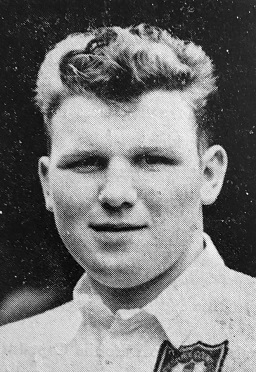Related Research Articles

Featherstone is a town and civil parish in the City of Wakefield, West Yorkshire, England, two miles south-west of Pontefract. Historically part of the West Riding of Yorkshire, in 2011 it had a population of 15,244. Featherstone railway station is on the Pontefract Line.

Featherstone Rovers are a professional rugby league club in Featherstone, West Yorkshire, England. The club play home games at Post Office Road and currently compete in the Championship, the second tier of British rugby league.
Andrew Fisher is a former professional rugby league footballer who played in the 1980s, 1990s and 2000s, and coached in the 2000s. He played at club level for Featherstone Rovers, Castleford, Dewsbury Rams, Hull FC, Wakefield Trinity (Wildcats) and the Barrow Raiders, as a prop or second-row, and coached at club level for the Dewsbury Rams, Sharlston Rovers and the Eastmoor Dragons.
Dennis Baddeley was an English professional rugby league footballer who played in the 1940s and 1950s. He played at representative level for Yorkshire, and at club level for Castleford, Wakefield Trinity and Featherstone Rovers, as a wing.
William Isaac C. Stott was an English professional rugby league footballer who played in the 1930s and 1940s. He played at representative level for England and Yorkshire, and at club level for Featherstone Rovers, Broughton Rangers, Oldham, Wakefield Trinity (captain) and Belle Vue Rangers, as a goal-kicking centre or stand-off.

Frederick "Eric" E. Batten was an English rugby union and professional rugby league footballer who played in the 1930s, 1940s and 1950s, and coached rugby league in the 1950s. He played club level rugby league (RU) for Sandal RUFC, and representative level rugby league (RL) for Great Britain and England, and at club level for Wakefield Trinity, Hunslet, Featherstone Rovers (captain), Leeds, Castleford and Bradford Northern, as a wing, and coached at club level for Featherstone Rovers, and Batley. Eric Batten appeared in eight Challenge Cup Finals; two for Leeds, five for Bradford Northern, and one for Featherstone Rovers, winning three, and losing five, he scored a total of 443 tries during his career, he his third on the all-time try scorers list behind Brian Bevan, and Billy Boston,
Albert Edward Terry was an English professional rugby league player who was active during the 1950s and 1960s. He played at representative level for Great Britain and Lancashire, and at club level for St Helens, Leeds, Featherstone Rovers and Castleford as a prop.
Harold Box is an English-born former professional rugby league footballer who played in the 1970s and 1980s. He played at representative level for Wales, Other Nationalities and Yorkshire, and at club level for Featherstone Rovers and Wakefield Trinity (captain), as a right-footed toe-end style goal-kicking fullback.
Freddie Miller was a professional rugby league footballer who played in the 1930s, 1940s and 1950s. He played at club level for Hull FC and Featherstone Rovers, as a right-footed toe-end style goal-kicking fullback, and was captain of Hull during the 1946–47 season.

Victor "Vic" Darlison was an English professional rugby league footballer who played in the 1930s, 1940s and 1950s. He played at club level for Goole ARLFC, the Featherstone Rovers, Castleford, Wigan, Wakefield Trinity and Bradford Northern, as a hooker or loose forward.
The Peckfield pit disaster was a mining accident at the Peckfield Colliery in Micklefield, West Yorkshire, England, which occurred on Thursday 30 April 1896, killing 63 men and boys out of 105 who were in the pit, plus 19 out of 23 pit ponies.
Wilfred Whitworth was an English professional rugby league footballer who played in the 1930s and 1940s. He played at club level for Oldham, Wakefield Trinity, and Featherstone Rovers, as a centre.
Frank Hemingway was a professional rugby league footballer who played in the 1930s, 1940s and 1950s. He played at club level for Featherstone Rovers and Wakefield Trinity, as a prop.
Jack Higgins is a former professional rugby league footballer who played in the 1940s. He played at club level for Featherstone Rovers, as an occasional goal-kicking scrum-half.
Arthur Haigh was an English professional rugby league footballer who played in the 1920s and 1930s. He played at club level for Featherstone Rovers, as a second-row.
Jimmy Williams was an English professional rugby league footballer who played in the 1920s. He played at club level for Featherstone Rovers, as a goal-kicking stand-off.
Raymond "Ray" Cording was an English professional rugby league footballer who played in the 1950s. He played at club level for Featherstone Rovers, as an occasional goal-kicking stand-off.

Henry Sharratt was an English professional rugby league footballer who played in the 1950s and 1960s. He played at representative level for England (Juniors), and Yorkshire (Juniors), and at club level for Stanley Rangers ARLFC, Wakefield Trinity, Featherstone Rovers, Bradford Northern, Dewsbury and Batley as a wing, centre, prop or second-row.
Roy Firth, also known by the nickname of "Bustler", is a former professional rugby league footballer who played in the 1960s and 1970s. He played at club level for Dewsbury, Wakefield Trinity (loan), Hull FC, Bramley and Featherstone Rovers (loan) as a hooker.
Cyril Knowles was an English professional rugby league footballer who played in the 1930s and 1940s. He played at club level for Fitzwilliam Juniors ARLFC, Wakefield Trinity, York and Featherstone Rovers, as a fullback.
References
- ↑ Bailey, Ron (1956). The Official History Of Featherstone Rovers R.L.F.C.. Wakefield Express. ASIN: B00O1TLDPC
- ↑ "The Featherstone Chronicle Great War 1915". The Featherstone Chronicle. March 1915. Retrieved 1 January 2017.